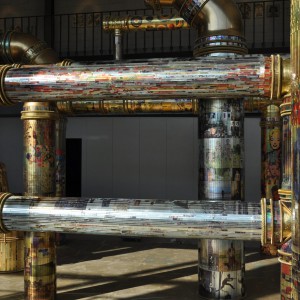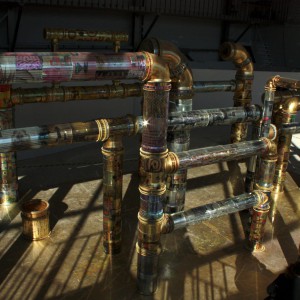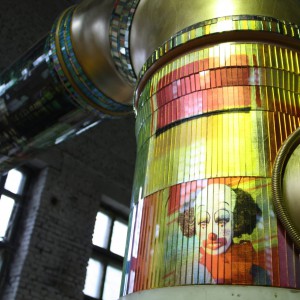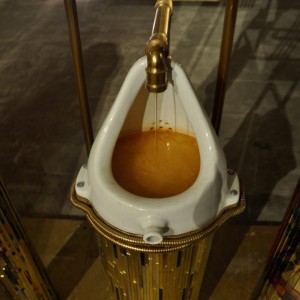Alchemy
Year: 2010
dimensions: 12x6x3mt
The Factory of Oxymorons
In the debates surrounding contemporary art, mosaic has been a notable absentee for several decades, perhaps since the 1940s, when Mario Sironi relaunched large-scale wall decoration within the Italian art scene. Sironi sought to create a new public art, once more capable of offering social stories of collective interest, an approach that had been long-surpassed by easel painting destined for the bourgeoisie. Instead, Sironi ended up trapped beneath the wings of fascism, the tragic sensibility evident in his work undermined by – and in seemingly unconscious contradiction to – the bombastic rhetoric of the regime. Gino Severini, another artist of the same period, had also advocated for a revival of artisanship, positing a notion of artist-craftsman that hearkened back to pre-Renaissance times. It is worth remembering the pair’s theoretical endeavors to give a new legitimacy, physiognomy and modern raison d'etre to mosaic, renewing its specific historical identity in light of a contemporaneity that moves ever further away from the bosom of tradition. The years after the Second World War swept away a great deal of the illusions held by Severini and Sironi, and a lot of water – murky and otherwise – passed under the bridge before experimental culture of the famous (or infamous) 1980s succeeded in clearing the way for new stylistic elements, tastes and artists. With a fresh attitude, certain protagonists began experimenting with techniques that had been previously considered obsolete by the cosmopolitan establishment, including mosaic. If the artist did not execute the mosaic himself, he did so via a third party, the skilled craftsman or pictor musivarius of ancient memory. Yet the notion of the unified artist-craftsman advocated by Severini was not entirely lost; in some cases, this dual identity thrived, strengthened by a heightened awareness of technique and the renewed challenge of interpreting the diverse conditions of the contemporary world. It is at exactly this point that operates the work of Dusciana Bravura, one of the strongest personalities in today’s mosaic art scene. Her work has continually challenged the conditions of the oxymoron – perhaps even unconsciously – at a moment when such oxymorons are a recurrent presence in society; the central paradox of Dusciana’s work arises from her use of an antique practice transferred into a modern time. In a society ever-increasingly turned away from memory and the past, she employs a manual skill that hearkens from our distant history, aimed at a mythological bestiary more closely tied to archaic literature than the cinematography of today. She interprets our shared fables and archetypes with a balance of manual skill, taste and thought that is precisely bound to this mode of creation; an ancient sensibility poured out within the modern condition. Herein lies the challenge that Dusciana confronts in her recent work, Alchemy, a piece of unusual scale and a new philosophical and logistical complexity that represents a decisive step in her mosaic practice, moving well beyond any conceptual and structural limitations of the form. The project began with the selection of one thousand works of art from the late 19th century to the present, which the artist printed on glass and cut by hand in accordance with mosaic practices, then reassembled on large industrial PVC pipes. The result is an almost labyrinthine course of images and light that envelops the visitor within its strange environment: a vast compendium of more than a century of art, offered through an individual sensibility within the mosaic dimension. Dusciana speaks of «a factory of contemporary art», a standpoint that is justified by her wide selection of pieces for inclusion. Presented side by side, works by the greatest historical protagonists and art’s supporting actors come together to reconstruct a dense network of relationships, derivations and consonances. Here we find the diversity, contradictions and counter-movements that marked time in the last century perhaps more than ever before; events, artistic movements, in short, the whole series of «-isms» and their respective opposites in the continuation of art historical traditions. The work constitutes, to quote Rosenberg, a «tradition of the new» – another resounding oxymoron – a notion largely left behind in the famous (or imfamous) 1980s by a more casual eclecticism that placed everything under the ambiguous and all-embracing banner of «postmodernism». In fact, if observed only briefly, the decorative refinement of Dusciana’s previous works could have suggested this historical-critical category, in the most proper sense of the term, their ancient craftsmanship and liveliness of invention quasi-incompatible with the analytical rigor, austere minimalism, and programmatic conceptualism extended within the internationally recognized academies. Certainly mosaic represents an expressive condition diametrically opposed to that of the New Avant-Garde. It seems natural to say that the practice of mosaic is inherently a choice of sides.
But to me the latest work of Dusciana seems to decisively shift the terms of the question, expanding its boundaries and complicating the perspective. We see clearly that these pieces are not simply copies of other known artworks. Of course, their legibility and recognizability is preserved insomuch as it is fundamental to a discourse on contemporary art. In a certain sense, one function of these images corresponds to that of a reproduction in a book. But it should be immediately added, to avoid any doubt, that there is nothing else here that can be traced back to a didactic historio- graphical reconstruction or critical research. Here, the images are transmitted through a technique that is always mosaic – even if the use of mosaic has been reimagined – and insofar as they recall other works and authors, they show themselves in the process of transformation. In the language of alchemy, this could be called transmutation. It is not for nothing that Dusciana refers to alchemy here, placing a replica of Fountain, the mythical pissoir of Duchamp, at the end of the tubes’ course to catch the single drop of gold that is issued forth, a symbol of the transmutation of the thousand different works evoked therein. It is as if the quintessence of contemporary art is being gathered by the pissoir, itself arguably the most revolutionary symbol of 20th century art, a piece both shocking and familiar. Said in these terms, Dusciana’s effort may seem an almost obvious simplification in homage to the world’s best known artwork, as has been true of the Mona Lisa with mustache and The Large Glass of the ineffable Duchamp. Yet like the first readymade, but with even more mockery in its provocation, Dusciana’s work may instead be the most cunning of all oxymorons, the piece most representative of this century’s artwork, at least in the line of the Avant-Garde representing the most radical negation of artistic tradition, identity and historically recognized values. The principle of the individuality and non-reproducibility of artwork, its pictorial and sculptural quality, these elements that make each artwork comparable to every other: all of this was swept away as if you were at the last stop of a long route of history. The paradox,course, is that the pissoir stands out like a trophy among museum works, gathered amidst those exemplary pieces of art history which, in a certain sense, it derides. Her use of well-known images from the history of art recalls Pop Art’s employment of recognizable cultural icons, led by unforgettable art darling Andy Warhol. Re-worked by Dusciana, the iconic artworks of the last century take on themselves the role of mass media images, an updated take on Warhol’s fetishes of consumerism. But where Dusciana’s references differ from those of the Pop Art movement is in their intention, their technical implementation, and their collective function in evoking a unitary vision of modernity. Along her path of abandoned piping -valid also for a sort of industrial archeology – come together the most diverse names from the history of art: from the prominent contemporary performance artist Marina Abramovic to the great painter Pierre Bonnard, from a protagonist of minimalism like Carl Andre to a symbol of eccentricity like Salvador Dali; from a proponent of Arte Povera like Mario Merz to a classic metaphysician like de Chirico; from Van Gogh to Ensor, from Picasso to Modigliani, as well as many artists of the present day like Anselm Kiefer, Marc Quinn, and Maurizio Cattelan. With an awareness that this is not so much an exemplary selection as it is a personal one, we move freely along the maze-like sequence to its conclusion, a sort of invoked alchemy that gathers all of this together and condenses it to offer a new possibility of interpretation. Viewed as a whole, the piece offers a fresh commentary on our perceptual, sensorial, and imaginative paths, a renewed inquiry into the nature of art.
What matters to Dusciana is the overall vision of a multi-faceted modernity, governed by linguistic and ideological choices so diverse as to seem incompatible at times, but for their mutual placement within the larger «system» of art. It is a system composed of virtually unbreakable chains between artists, collectors, critics, museums, and institutions dedicated to art. Dusciana’s vision is, so to speak, an ecumenical one; she suggests a willingness to lead the multifaceted world of contemporary art back to the unifying vision of the mosaic artist, asserting the compatibility of her ancient technique with contemporary artistic expression the thought that underlies it, the rules that govern it, and the consensus that legitimizes it. She suggests once more the tautology of Dino Formaggio, the affirmation that art is whatever people call art.
While Dusciana’s work is decisively conceptual, it does not renounce the valor of materials, of technique, or of a surprising setting for a site-specific project whose means and end is the literal quotation. The gap between the traditional mosaic transposition and the sequence of citations found in Dusciana’s work lies in their technical treatment, which restores to mosaic a new appearance, function, and destiny.
If the relationship between the mosaic and contemporary art has appeared as one of the most problematic questions amidst this almost deafening operation, then we are also celebrating a fascinating and unpredictable figure of our time: the oxymoron.
Claudio Spadoni















